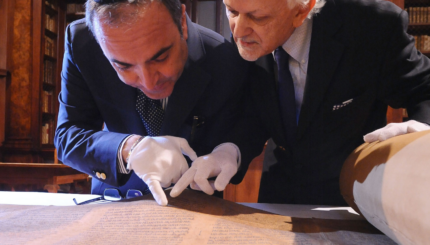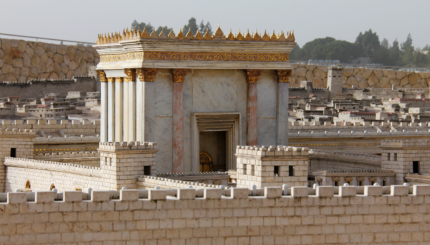Polygamy was a common practice in Judaism since ancient times, though it has become exceedingly rare in the modern era. While women have never been permitted to have more than one husband in Jewish law, the Hebrew Bible describes several men as having more than one sexual partner, either wives or concubines. The patriarchs Abraham and Jacob had multiple wives, as did Kings David and Solomon.
Both biblical and rabbinic law regulated polygamy and thus implicitly sanctioned it. But there’s ample evidence that Jewish tradition is deeply uncomfortable with the practice, which was banned outright for Ashkenazi Jews more than a millennium ago. Sephardic Jews continued to practice polygamy in countries where it was common for centuries thereafter. But today, the practice is virtually extinct among Jews of all traditions.
Polygamy in the Bible
The first account of a couple in the Bible seems to establish monogamy as the ideal. In Genesis, God creates Eve out of Adam’s rib and gives her to him as a wife. God then commands: “Therefore a man leaves his father and mother and clings to his wife, and they shall become one flesh.” Many biblical scholars read this story as upholding monogamous marriage as the divine ideal. They note the verse states man should cling to “his wife” (singular), indicating only one. They note the use of the Hebrew phrase al ken (therefore) as indicating this model is one intended for all of humanity to follow. And the Jewish mystical tradition teaches that the union of male and female is a return to a primordial state of oneness enacted by the spiritual act of marriage.
Yet the Bible also relates multiple instances in which this ideal is not upheld, beginning in Chapter 4 of Genesis, which relates that Lamech, a descendant of Cain, took two wives. Later we learn that Abraham took a second wife, Hagar, after his first wife Sarah failed to conceive. (Sarah later bore him a son, Isaac, the only one of the biblical patriarchs that did not take multiple wives.) Jacob had two wives, Leah and Rachel, and had children with two other women as well, Bilha and Zilpa, though their status is somewhat ambiguous. The Bible states they were given to Jacob l’isha, commonly translated as “for a wife,” though there are indications they enjoyed a lesser status than Leah and Rachel and they are not included among the Jewish matriarchs.

Help us keep Jewish knowledge accessible to millions of people around the world.
Your donation to My Jewish Learning fuels endless journeys of Jewish discovery. With your help, My Jewish Learning can continue to provide nonstop opportunities for learning, connection and growth.
Later in the Bible we find that King David had children with multiple wives while his son, Solomon, had 700 wives. In the Book of I Samuel we learn about Elkanah, who had two wives, Peninah and Hannah, the latter of whom had difficulty conceiving, prayed for a child and was answered, a story read in synagogue on Rosh Hashanah.
The Bible also requires the taking of a second wife in one particular instance: If a married man dies childless, his surviving brother is obligated to take his widow as a wife to continue the brother’s lineage even if he is already married, an institution known as levirate marriage.
Yet already in the Bible, there is evidence that taking multiple wives is not an ideal practice.
The polygamous marriages described in the Bible were undertaken for particular purposes and were clearly not pleasant ones. Sarah urges Abraham to marry Hagar only because she is unable to have a son herself. Later, after witnessing Hagar’s child acting inappropriately, Sarah instructs Abraham to cast both mother and child out of the house, which he does. Jacob marries Rachel and Leah only because he is deceived by their father Laban. Leah always feels the lack of Jacob’s love and Rachel later becomes jealous of Leah when she is unable to conceive. Given the importance the Bible ascribes to procreation — the first commandment God gives to humanity is to be fruitful and multiply (Genesis 1:28) — the fact that both these polygamous marriages were connected to infertility can be read to imply that polygamy was an allowance due to need.
Later books of the Bible continue to describe polygamy in less than admiring terms. David’s lust for Bathsheba led him to sin by sending away her husband to die in war so he could take her for a wife. Solomon’s many wives, the biblical text makes clear, led to his embrace of idolatry: “He had seven hundred royal wives and three hundred concubines; and his wives turned his heart away.” (I Kings 11:3)
Yet, the Bible also includes numerous rules meant to regulate polygamy, which suggests that it was, at a minimum, tolerant of it. Deuteronomy 17:17 states that a king is not to have “many wives, lest his heart go astray.” Exodus 21:10 requires a man who takes a second wife not to deprive the first of food, clothing and sex — and if he does, the first wife is released from the marriage. The Bible also prohibits a man from taking his wife’s sister as a second wife. These laws indicate the Bible’s acceptance of polygamy to an extent while also seeking to circumscribe it.
Polygamy in the Talmud
The mixed approach to polygamy continues to be reflected in the Talmud, which elaborated on the Bible’s regulation (and thus sanctioning) of the practice while also conveying a certain discomfort with it. The Talmud (Yevamot 65a) records a teaching that a man may take several additional wives provided he has the means to support them all, though elsewhere in the same tractate (44a) the Talmud suggests four wives should be the limit. And the Talmud states that a woman could demand a divorce — something she’s normally not allowed to do — if her husband decided to take a second wife. The Talmud’s word for a co-wife, tzarah, is related to the Hebrew root meaning “trouble.”
The rabbis of the Talmud themselves did not take multiple wives. The one partial exception to this is Rabbi Tarfon, who we are told (Tosefta Ketubot 5:1) betrothed (not married) 300 wives during years of famine. Rabbi Tarfon happened to be extremely wealthy, and as a priest was entitled to the gift of tithes, meaning he had plenty of food. So it’s likely his betrothal to so many was more an act of charity than lust.
The Decree of Rabbeinu Gershom
The first explicit statement outlawing polygamy for Jews came from Rabbeinu Gershom, a renowned French talmudist who, around the year 1,000 CE, declared a ban on polygamy. Violators were to be subjected to a punishment of herem, or excommunication. The reasons for this ruling remain in dispute and the edict was apparently intended to expire after several hundred years, but it became the norm in Ashkenazi communities. In some Sephardic communities, however, men continued to take more than one wife. There is evidence that polygamy continued to be practiced by the Jews of Iberia before their expulsion in the late 15th century and even later in Yemen and North Africa, where the practice remained broadly common.
The Shulchan Aruch, the principal medieval code of Jewish law, published more than 550 years after Rabbeinu Gershom’s decree, rules that a man is permitted to marry several women provided he can support them. However it also approvingly cites the Talmud’s “worthy suggestion” that four is an appropriate limit, bans the practice outright in places where monogamy is the norm, and suggests that it would be a good idea to issue a takanah (corrective decree) banning it entirely.
The Rema, a commentator on the Shulchan Aruch whose rulings are considered authoritative by Ashkenazi Jews, notes that despite the fact that Rabbeinu Gershom’s decree had technically expired, the custom in “these lands” — most likely the areas of Europe where Rabbeinu Gershom’s authority was recognized — was to marry only one wife and to punish those who did otherwise.
The only exceptions to Rabbeinu Gershom’s decree are levirate marriage and an obscure provision known as heter me’ah rabbanim — literally “the permission of 100 rabbis.” In certain circumstances, 100 rabbis from three countries may authorize a man to marry a second wife even though he’s already married. The provision is rarely applied, and typically only in cases where a man cannot divorce his wife according to religious law for some particular reason (perhaps the wife has disappeared and cannot be given a get, or religious writ of divorce). There have been reports that this allowance has been subject to abuse, such as a 2014 case featured in The New York Times where a man declined to divorce his wife, effectively preventing her from marrying someone else, while he secured a heter me’ah rabbanim to marry someone else.
Polygamy in Modern Times
In the modern era, polygamous Jewish marriage has grown increasingly rare, though it has never disappeared entirely. Given the rulings noted above, it is virtually unknown among Ashkenazi Jews (who consider Rabbeinu Gershom and the Rema authoritative), but has continued among Sephardic Jews (who consider the Shulchan Aruch authoritative) in countries where the practice was accepted. Even into the 20th century, some Sephardic religious authorities maintained that polygamy should be permitted under certain circumstances.
In 1931, a man was fined by a Jerusalem court for marrying a second wife without divorcing the first, who apparently had no problem with it. A lawyer argued that the practice should be allowed, since Rabbeinu Gershom’s edict had expired, but the court disagreed.
A few years after the founding of the State of Israel, the Ashkenazi and Sephardic chief rabbis jointly agreed to ban polygamy, with the latter apparently going along with it because by then most Sephardic communities had already left the practice behind. But not all Sephardic authorities agreed — most famously Ovadia Yosef, then a judge on the rabbinical court of Petach Tikvah and later the Sephardic chief rabbi of Israel, said the ruling of the chief rabbis was invalid and that communities where polygamy was practiced should be allowed to continue to do so even in modern Israel. The state only formally outlawed polygamy in 1977, though the law carves out exceptions if approved by the chief rabbinate.



